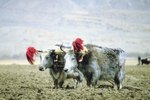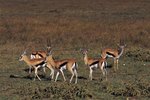
The Earth has two tundra environments. Alpine tundras exist on mountains around the globe, and the Arctic tundra radiates out from the north pole. The primary tundra animals with antlers are caribou, also known as reindeer. Moose sometimes dwell at the outer edge of the Arctic tundra, and elk are sometimes present in North American alpine tundras. Mountain goats inhabit alpine tundras around the world, but they have horns, not antlers.
Caribou/Reindeer
Caribou or reindeer roam across Arctic tundra in the Eastern and Western hemispheres, sporting impressive antlers up to 4 feet wide. Both males and females grow antlers. The names "caribou" and "reindeer" are generally used interchangeably, but the former is more often applied to the animals in North America, while the latter is more common in Europe and Asia. The two names refer to the same species, yet some physical differences muddle the distinction, or lack thereof. Historically, the animals known as reindeer have been domesticated and herded, and over the generations, this made them slightly smaller and more tame.
Moose
Moose are the largest species in the deer family, and their enormous antlers can spread up to 6 feet across, though they are typically closer to 4 feet from tip to tip. Though they might not look it, moose are able swimmers that sometimes travel miles by river and can submerge for up to 30 seconds. They're also swift runners, sprinting at up to 35 miles per hour. Moose inhabit lower portions of Arctic tundra and just below its southern boundaries. They head farther up into the tundra in the summer, when it becomes a bit more hospitable and offers more plants to eat.
Elk
Elk are not primarily a tundra animal, but in summer they migrate to alpine tundras of North America to give birth. Though their antlers are skinnier and less broad in span than the antlers of caribou, reindeer, and moose, they have considerable height. Elk antlers reach up to 4 feet tall, giving these animals a total height of up to 9 feet. These animals lose their antlers annually in March and begin regrowing them every May. In fact, all animals with antlers shed and regrow them annually, though different species do so at different times of year.
Why Antlers
Having to carry around giant bony growths protruding from your head might seem an odd evolutionary choice, especially since they must be regrown annually. The added weight and energy expenditure would seem a hindrance in the harsh tundra environments of brutal cold and scarce food. But antlers are key to establishing dominance and mating priority among deer species. Size does matter. Antler size is unrelated to an animal's age, but it is an important signifier of health; the bigger they are, the healthier the animal, and that's essential information when choosing the best mate. Antlers are also important for fending off predators, and they're the weapons of choice when two animals of the same species battle for dominance or a mate.
References
Photo Credits
-
Photos.com/Photos.com/Getty Images
Writer Bio
Eric Mohrman has been a freelance writer since 2007, focusing on travel, food and lifestyle stories. His creative writing is also widely published. He lives in Orlando, Florida.



